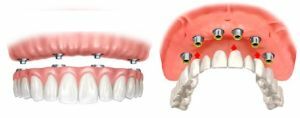 Prosthesis is a necessary procedure in the absence of one or more teeth. This is done not only to restore the aesthetic appearance of the oral cavity and to cover the gaping hole in the dentition, but also to avoid health problems.
Prosthesis is a necessary procedure in the absence of one or more teeth. This is done not only to restore the aesthetic appearance of the oral cavity and to cover the gaping hole in the dentition, but also to avoid health problems.
Absence of teeth leads to subsidence of bone tissue, displacement of the remaining teeth, and subsequent changes in the structure of the jaw. In addition, there may be problems with the gastrointestinal tract due to the fact that the food will not be chewed well enough.
That's why after losing a tooth, it is advisable to start installing the prosthesis in a short time, before the atrophy of bone tissue has begun.
Contents
- Application of fixed structures
- When do you choose a removable prosthesis?
- Versions of fixed structures
- All types of fixed structures
- About crowns know all. ..
- Installation of
- bridge Microprosthesis
- Installation of implants
- Installation: process features
- Advantages and disadvantages
- Care of the prosthesis
- For completeness of the picture
- For each layer of the population
- All types of fixed structures
Application of fixed structures
The prosthesis completely replaces the lost tooth, performing its function. Fixed prosthesis can be installed with the loss of one or more teeth, having a different design and material. 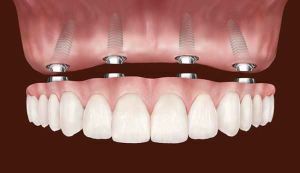
The only common feature of such prostheses is that they can not be removed without the help of a doctor.
Non-removable structures are chosen in cases where partial prosthetics are necessary, that is, the patient did not lose all teeth at once.
With complete loss of teeth, the only possible option is permanent fixation on implants, but it is rarely chosen, giving preference to removable options in this case.
When do you choose a removable prosthesis?
In certain cases, dentists recommend the installation of detachable structures:
- when the patient has no more than three teeth running in succession;
- in case of need of full prosthetics, with absence of all teeth;
- in the presence of a "terminal" defect - when there are no last, molars;
- if periodontitis or other disease that destroys the dental roots is found.
The patient can remove the removable structures at any time to rest from them or clean them.
Versions of fixed structures
There are many variants of non-removable structures, they differ in purpose, type and material.
Crowns know everything. ..
Single crowns - suitable in cases where the tooth is not completely destroyed, and its root has retained its function and stability. In this case, the artificial crown replaces the natural crown. Such prostheses can be classified according to the composition from which they are made:
- Metallic , the same category includes alloys from any metals. These crowns are conspicuous, immediately stand out in the mouth, so they are usually used for chewing teeth. In addition, they are contraindicated in patients with allergies to metal. The advantages of this option are low cost.
- Non-metallic - this includes various materials: porcelain, ceramics, plastic. Ceramic and porcelain crowns do not have very high strength, but they are hypoallergenic and do not catch sight. Plastic options, in comparison with others, are short-lived.
- Combined variants of combine the advantages of the previous two, for example, metal-ceramic crowns, durable and durable.
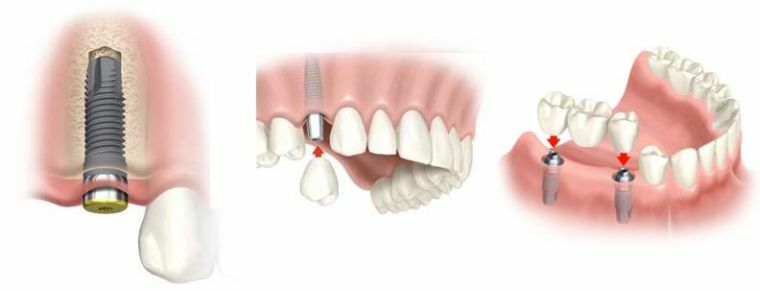
Installation of the bridge
Bridges consist of several crowns, fixed to healthy teeth, which are used as a support, and are similar in appearance to the bridge, hence the name.
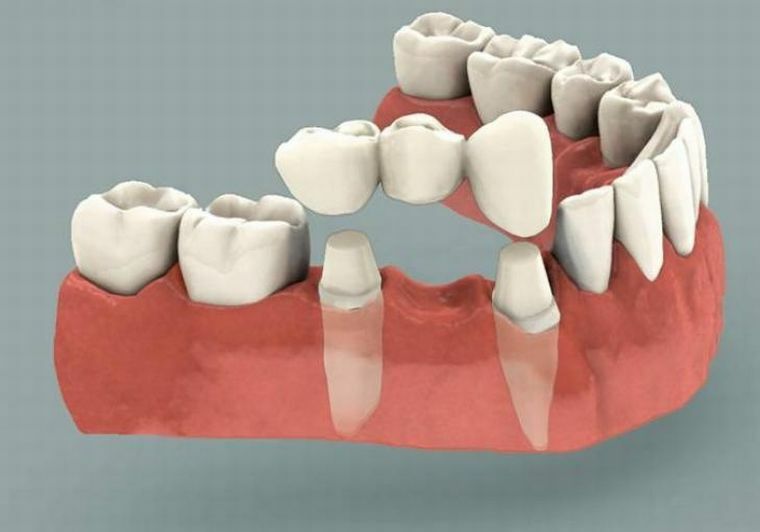
There are different types of prostheses, differing in both material and method of attachment:
- Metal - the most budgetary option, usually used on molars. They are simply fixed and manufactured.
- Ceramic - refer to aesthetic options.
- Combined - cermet, metal plastic - combine the advantages of different materials.
- Adhesive , created from special composite materials, is attached using a medical adhesive.
- Prosthes fastened with special locking structures .
Microprosthetics
Usually this method is chosen as an alternative to conventional seals, when for some reason they are not suitable. Such prostheses are suitable if the tooth is not completely destroyed or there is some defect, for example, a cleft that needs to be hidden.
There are two types of micro-prostheses: 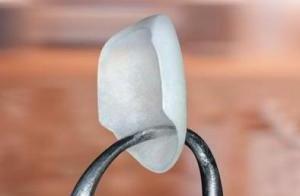
- tabs set at large damages, they look more aesthetic than the seal, can fully withstand the chewing load;
- veneers are thin plates, they are usually fixed on the front teeth to hide some defect. In appearance, they are somewhat reminiscent of false nails, while the veneer looks very natural, it can not be distinguished from a real tooth.
Installation of implants
Implants consist of two parts - a non-removable pin that replaces the root of the tooth, and a crown part replacing the natural crown of the tooth.
The pin is usually made of metal and screwed into bone tissue, and the crown is fastened from above, which will perform the chewing function.
This technique allows you to restore your teeth even if you lose more than three in a row, because the implants do not need a bridge support. However, it is worth remembering that you will have to insert the pins - one for each new tooth.
Installation: Process features
Despite the difference in design, the preparatory stage and installation of fixed prostheses has many similarities:
- Before prosthetics, the needs to assess the condition of the oral cavity and choose the appropriate design. Usually the doctor suggests the relevant options and tells about their features, and the final decision remains with the patient.
- When a design is chosen, needs to bring nearby teeth in order , the existing diseases of the oral cavity are eliminated.
- If the required prosthesis is a bridge , adjacent teeth are grinded. To implant the implants, a pre-installation of the pin is necessary.
- The crown part for any prosthesis is made individually, taking into account the peculiarities of the structure of the jaw, teeth and their color.
- When everything is ready, the dentist performs fitting, fitting and installing the .Correction of inaccuracies of closing is possible.
Advantages and disadvantages of
Like all designs, fixed prostheses have their pros and cons.
The following factors can be attributed to the advantages:
- Long service life - veneers are able to maintain their function, on average, up to 7 years, crowns and cultic tabs can last for all 20 years.
- Designs are firmly and securely fixed , they will not fall out at the most inopportune moment.
- There are aesthetic options for - lumineers, ceramic crowns, which are almost invisible to others. Therefore, even if you constantly work with people, no one will notice that part of your teeth is artificial.
- Prosthes are able to fully withstand the chewing load, successfully replacing the natural teeth .
- Modern designs of minimize the taste sensitivity of to a minimum, they are quite easy to care for and do not require a long period of adaptation and adaptation for the patient.
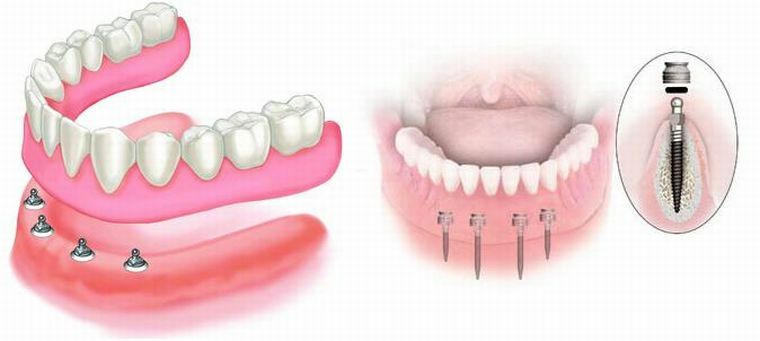
In the photo there are full non-removable dentures on 4 implants
However, prostheses have drawbacks.
- possible irritation of soft tissues ( periodontium) due to contact with the edges of the installed crowns;
- the patient can develop a pathological complex of symptoms - the presence of metallic taste in the mouth, pain, burning on the mucous membrane, lips and tongue, changing taste sensations;
- need to sharpen adjacent, healthy teeth , to install certain types of prosthesis;
- some fixed designs quite expensive and not everyone can afford.
Care for the prosthesis
In general, the care of the prosthesis is no different from the usual hygiene procedures. The only nuance is to do it with great care, using not only the brush, but also the dental floss, as well as the rinse composition.
Also, clean the dentures at least twice a day and avoid mechanical damage.
There are some additional recommendations:
- it is undesirable to crack solid objects - shells of nuts, seeds;
- should reduce consumption of too tight or viscous food;
- is not recommended to eat too hot food or, conversely, very cold.
As a preventive measure, it is necessary to visit a doctor no less than once every six months so that he can examine the condition of the prosthesis. It is also advisable to inspect them on a regular basis - if suddenly there was a crack somewhere, this is an occasion to turn to the dentist.
For completeness of the
picture What dentists think about permanent teeth replacement can be learned by examining their reviews.
Teeth after chemotherapy began to loosen up, drop out. It was possible to restore them with implants. They look very natural, you can easily eat with them - there are no problems. The installation process was quite long and more expensive than conventional prostheses, but it's worth it, because teeth are like new ones!
Irina
I made a crown on the tooth, I thought that it would have to be pulled out, but the doctor said that it is possible to put a permanent prosthesis. Before the installation had to undergo treatment, from all these procedures, the gum hurted and covered, but I constantly rinsed my mouth and used the ointment that the doctor advised. Then they first put a temporary crown, the gum was also ill. And when they established a constant, everything was normalized, now I do not remember it at all.
Alexander
A piece of tooth split from the front - it was very ugly looking, it was necessary to hide a smile. I went to the dentist - he advised me to make a veneer. I was very pleased, the color of the prosthesis is ideally merged with the teeth, and it is not visible, you can again calmly communicate, not being afraid that someone will notice the problem with the tooth.
Olga
For each layer of the population
The cost of prosthetics directly depends on the type of construction used. Depending on the chosen design, the cost of installing a non-removable denture will be: 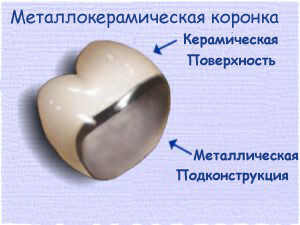
- cermet bridges and crowns cost from five thousand for one crown;
- for ceramic the cost starts from 16 thousand;
- veneers from ceramics - from 12 thousand;
- implants - from 30 thousand, on average.
The installation of the prosthesis will allow you to restore the function of the teeth and avoid problems with the oral cavity and the gastrointestinal tract, so if you lose a tooth or several, you need to contact the clinic as soon as possible.
Certain designs are prescribed, depending on the specific case, so it is worthwhile to listen to the doctor's recommendations. However, for sure, he will offer several alternatives at a cost, from which you can choose the optimal one.
